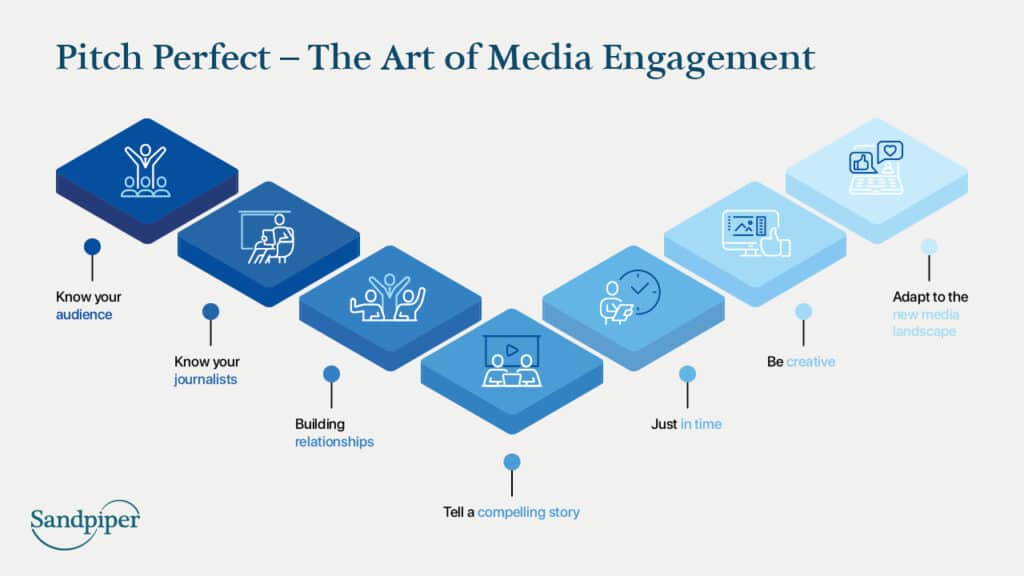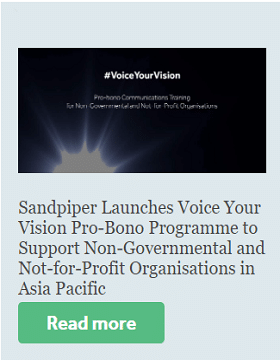
Vaccine Equity Across Asia Pacific

Be Up-To-Date on AI Policy
Stop Press: Getting Your Story Published in the Ever-Evolving Media Landscape
June 2023

By Charlotte Whale, Senior Consultant of Sandpiper based in New Zealand. Charlotte had a 20-year career as a journalist, working for some of the biggest global networks including BBC World TV and Al Jazeera. She has a deep understanding of the mechanics of a newsroom and the modern-day challenges facing the media. She can easily identify what makes a good story that’ll appeal to journalists and how people and organisations can best craft and land their message in the most impactful way when speaking to the media.
Over the last decade, the media industry has undergone a significant transformation, particularly in the newsroom. The rise of digital media and social media has created more competition and unprecedented financial pressures for traditional news outlets. Audiences have switched their behaviours, not only the way in which they access news, but also their trust in news and the types of news they want to read about. In this ever-evolving landscape, how are journalists maintaining their integrity, and how do you need to change your strategy to ensure you get your stories published?
Shifting media landscape
A recent report found that there are only seven markets worldwide where consumers spend more time on traditional rather than digital media, all European except for Japan. However, while print media has declined significantly, most traditional news outlets have switched to digital publication either in tandem with, or instead of print. The good news is that 65% of global internet users either increased or maintained their online newspaper readership in the last 12months.
On the flipside, the decline in print media has resulted in a significant decline in revenues for news outlets and they’ve had to find new ways to adapt and survive. Some have found new revenue streams, such as events or podcasts. Others have turned to a subscription news model which is gaining in popularity, with 14% of South Koreans, 17% of Singaporeans, and 22% of people in Hong Kong paying for online news, according to the Digital News Report 2022 by Reuters Institute.
Advertising, always an important source of revenue, is now even more vital. However, this is putting pressure on journalistic integrity as advertisers demand proof of readership or viewership ( in the case of broadcast news) and place pressure on newsrooms to produce content that is more likely to attract their target audience. Outlets can feel like they need to focus on popular topics which can compromise editorial judgement and lead to sanitised news. It’s a huge challenge for news outlets to generate revenue without compromising on their editorial integrity or independence. As a result, many outlets have scaled back their operations, often losing senior reporters, significantly impacting the overall quality of journalism.
Faux facts and falsehoods: navigating the murky waters of fake news and misinformation
Trust in the news has fallen worldwide in recent years. The Digital News Report 2022 by Reuters Institute also found just 42% of people trust the news. People are also suffering from news fatigue, with overall interest in news falling to 51% from 63% in 2017. Consumers are tired and wary of fake news and misinformation after a flood of Covid-19 conspiracy theories and political campaign propaganda, particularly in the US. The rise of deepfakes, videos or images which have been manipulated to show something that never happened, is also a significant concern. Deepfakes can be difficult to spot and have a significant impact on public opinion. Journalists have had to work tirelessly to fact-check and verify information to ensure that their reporting is accurate and reliable as well as ensuring the authenticity of videos.
Raising the bar in today’s media: journalistic quality
In this environment, the quality of journalism has been eroded. With too few senior journalists, lack of training for new ones, and tight deadlines, several well-known news outlets have been caught out for using the wrong content when reporting the Russian invasion of the Ukraine, the Syrian War, and the 2023 Turkish earthquake. The 24/7 news cycle means that the pressure to produce content quickly, particularly in breaking news situations, is immense. Unfortunately, these mistakes can significantly erode the trust of audiences.
Assessing credible media: who can we trust?
In this complicated and ever-shifting landscape, it is possible to identify news that can be trusted. Many traditional outlets have a long-standing reputation for quality journalism like the Financial Times, The Economist, The New York Times, The Washington Post, and The Guardian. All these publications have a strong commitment to editorial independence and aren’t influenced by commercial pressures. They also have a reputation for producing in-depth, high-quality journalism that is respected and trusted by their audiences.
There are also new digital-only platforms such as Vice which has gained a reputation for producing in-depth, investigative journalism that is both informative and engaging. The platform’s commitment to editorial independence and its willingness to cover stories that other outlets may not have the resources or inclination to cover have helped to build trust with its audience.
These are global platforms, but when we come down to the country level, the outlets that people trust are more varied:
- Singapore – 43% of people trust the news and the top five trusted outlets are Channel News Asia, Channel 5 News, The Straits Times, Channel 8 News and the BBC;
- In Hong Kong, 41% of people trust the news and the top five trusted outlets are Hong Kong Now TV news, Yahoo! News, Headline Daily, i-CABLe/Ming Pao/Commercial Radio (joint fifth place); and
- In Australia, 41% of people trust the news and the top five trusted outlets are the ABC, SBS, regional newspapers, the BBC, and Channel 7.
Pitch perfect: mastering the art of getting your pitch across the line in media’s modern maze
In this complicated and ever-shifting landscape, how can you pitch your client successfully and get the best quality coverage with trusted outlets?

Know your audience
While we’ve discussed some quality publications above, it’s no use if your target audience doesn’t read them. You must first understand your client’s objective and then work out the interests, demographics, and preferred media consumption habits of the audience you want to target. For instance, 39% of social natives (18-24s) use social media as their main source of news, particularly Tik Tok and Instagram, while digital natives (25-34s) are more likely to use Facebook.[6] Older business professionals are more likely to be reading Forbes or The Wall Street Journal. If you haven’t conducted a full media audit for a couple of years, then your intelligence is likely to be out of date.
Know your journalists
Once you’ve identified what your target audience is reading, then you need to find journalists who have a particular interest in your area. You are far more likely to be successful if you understand who is on your beat. Do your research, follow them on social media, and engage with their content.
Building relationships
Establish trust and rapport with the right journalists – they are people too! Having an existing relationship will make pitching successfully much easier. Invite them to an off-the-record chat so that you can get a feel for what they’re interested in, have them meet your client’s spokesperson, and help develop leads for stories. This can also help you and your spokespeople to become the go-to experts on hot topics. Be available to answer questions and provide quotes at short notice.
Build compelling stories that can’t be ignored
It’s all in the story and you need to stand out in a crowded media landscape. Look for a new angle, or a personal anecdote which makes your story special. For instance, ESG is a hot topic, so you could focus on sustainability or greenwashing if there’s a relevant connection to your brand. Ensure your information is accurate and you back up your story with compelling data. Commissioning research reports that link to your brand story and that provide new and interesting insights can also win you coverage.
It’s all in the timing
Look at the news cycle for opportunities to peg your article to a big event like DAVOS or International Women’s Day. Many publications will also have an editorial calendar that you can access for forward planning. Equally, watch out for these big events if your story doesn’t connect to them. You can have a brilliant pitch, but if journalists are focusing their attention on something else, then you will lose out.
Be creative
76% of journalists still want to see your press release[7] but some popular titles receive hundreds every day. If you want a journalist to open your press release, then you need to send an email with a compelling title and key points and data laid out. Make sure you have taken note of any formatting requirements or editorial style notes. With dwindling budgets and staff numbers, journalists will appreciate anything you can do to make their jobs easier. Package your press release with graphics, videos or images, and infographics. 54% of journalists say they are more likely to cover a story if provided with multimedia. [8] More traditional events, junkets, roundtables, and providing product samples are also still effective tactics to grab journalists’ attention.
Work with the new landscape
PR teams need to be flexible to operate successfully within the new media landscape and think outside the box
- Partnerships – These can be a highly effective way to reach out to new audiences and build brand awareness. A collaboration between a client and a media outlet to achieve a common goal – they can drive more traffic to their sites/ get more reader hits or views, and you can tap into their expertise and audience. Partnerships are different to paid media, because the content is provided not created. You work together with a media outlet to find creative ways to tell a story, introduce a product.
- Influencers – Collaborate with influencers in media/marketing partnerships. This could be a social media influencer, but is equally likely to be a sportsperson, or successful entrepreneur. These collaborations may be paid, but an influencer may also be happy to do an interview in exchange for product samples or simply for the additional exposure.
- Expert insight – It’s great if you have your own expert spokesperson, but equally you can reach out to other experts for comment. For example, if you are pitching a story about your client’s sustainable fashion brand , you could reach out to experts in the fashion industry who have a track record of promoting sustainable practices. This will add to your credibility by association.
- Not just the journalists: Most TV news shows, and even larger publications will have a planning desk. These will be staffed by bookers for shows, planning producers and planning teams. If your story isn’t time-dependent, it’s worthwhile getting to know these people. Again, take the pain out of their lives and help them with their jobs, provide talking points and multimedia material.
Pitched to perfection: sealing the deal
The change in media landscape and audience habits can be daunting, but it’s also a great opportunity to shake up your media strategy. Think outside the box with your pitches, appreciate the constraints on journalists’ time, and do as much of the legwork for them as you possibly can.
Of course, some of the fundamentals haven’t changed – building relationships with the right journalists and developing compelling stories is still the foundation of getting great media coverage. Ensure your stories are accurate, be reliable, and available and you will be pitching to perfection.




